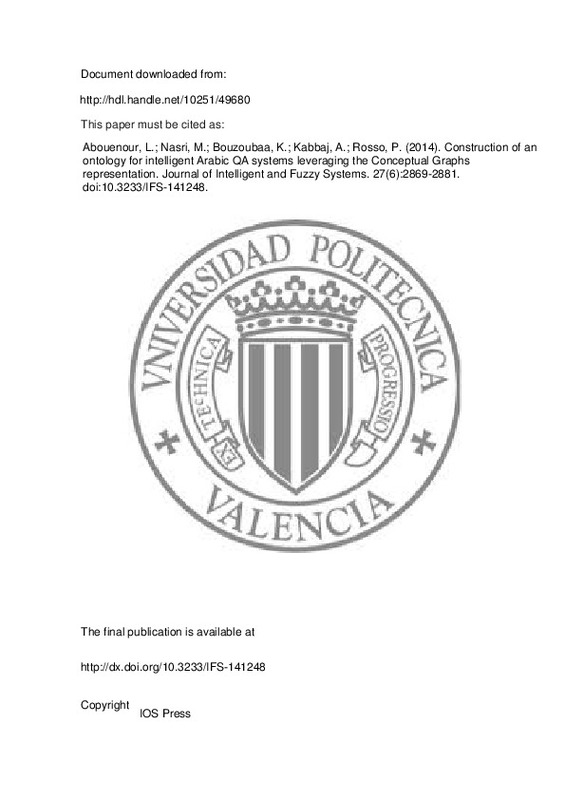JavaScript is disabled for your browser. Some features of this site may not work without it.
Buscar en RiuNet
Listar
Mi cuenta
Estadísticas
Ayuda RiuNet
Admin. UPV
Construction of an ontology for intelligent Arabic QA systems leveraging the Conceptual Graphs representation
Mostrar el registro sencillo del ítem
Ficheros en el ítem
| dc.contributor.author | Abouenour, Lahsen
|
es_ES |
| dc.contributor.author | Nasri, Mohamed
|
es_ES |
| dc.contributor.author | Bouzoubaa, Karim
|
es_ES |
| dc.contributor.author | Kabbaj, Adil
|
es_ES |
| dc.contributor.author | Rosso, Paolo
|
es_ES |
| dc.date.accessioned | 2015-05-05T09:15:22Z | |
| dc.date.available | 2015-05-05T09:15:22Z | |
| dc.date.issued | 2014 | |
| dc.identifier.issn | 1064-1246 | |
| dc.identifier.uri | http://hdl.handle.net/10251/49680 | |
| dc.description.abstract | The last decade had known a great interest in Arabic Natural Language Processing (NLP) applications. This interest is due to the prominent importance of this 6th most wide-spread language in the world with more than 350 million native speakers. Currently, some basic Arabic language challenges related to the high inflection and derivation, Part-of-Speech (PoS) tagging, and diacritical ambiguity of Arabic text are practically tamed to a great extent. However, the development of high level and intelligent applications such as Question Answering (QA) systems is still obstructed by the lacks in terms of ontologies and other semantic resources. In this paper, we present the construction of a new Arabic ontology leveraging the contents of Arabic WordNet (AWN) and Arabic VerbNet (AVN). This new resource presents the advantage to combine the high lexical coverage and semantic relations between words existing in AWN together with the formal representation of syntactic and semantic frames corresponding to verbs in AVN. The Conceptual Graphs representation was adopted in the framework of a multi-layer platform dedicated to the development of intelligent and multi-agents systems. The built ontology is used to represent key concepts in questions and documents for further semantic comparison. Experiments conducted in the context of the QA task show a promising coverage with respect to the processed questions and passages. The obtained results also highlight an improvement in the performance of Arabic QA regarding the c@1 measure. | es_ES |
| dc.description.sponsorship | The work of the last author was carried out in the framework of the WIQ-EI IRSES project (Grant No. 269180) within the FP 7 Marie Curie, the DIANA APPLICATIONS - Finding Hidden Knowledge in Texts: Applications (TIN2012-38603-C02-01) project, and the VLC/CAMPUS Microcluster on Multimodal Interaction in Intelligent Systems. | en_EN |
| dc.language | Inglés | es_ES |
| dc.publisher | IOS Press | es_ES |
| dc.relation.ispartof | Journal of Intelligent and Fuzzy Systems | es_ES |
| dc.rights | Reserva de todos los derechos | es_ES |
| dc.subject | Ontology | es_ES |
| dc.subject | Conceptual Graphs | es_ES |
| dc.subject | Arabic Natural Language Processing | es_ES |
| dc.subject | Question Answering | es_ES |
| dc.subject | WordNet | es_ES |
| dc.subject | VerbNet | es_ES |
| dc.subject.classification | LENGUAJES Y SISTEMAS INFORMATICOS | es_ES |
| dc.title | Construction of an ontology for intelligent Arabic QA systems leveraging the Conceptual Graphs representation | es_ES |
| dc.type | Artículo | es_ES |
| dc.identifier.doi | 10.3233/IFS-141248 | |
| dc.relation.projectID | info:eu-repo/grantAgreement/EC/FP7/269180/EU/Web Information Quality Evaluation Initiative/ | |
| dc.relation.projectID | info:eu-repo/grantAgreement/MINECO//TIN2012-38603-C02-01/ES/DIANA-APPLICATIONS: FINDING HIDDEN KNOWLEDGE IN TEXTS: APPLICATIONS/ | es_ES |
| dc.rights.accessRights | Abierto | es_ES |
| dc.contributor.affiliation | Universitat Politècnica de València. Departamento de Sistemas Informáticos y Computación - Departament de Sistemes Informàtics i Computació | es_ES |
| dc.description.bibliographicCitation | Abouenour, L.; Nasri, M.; Bouzoubaa, K.; Kabbaj, A.; Rosso, P. (2014). Construction of an ontology for intelligent Arabic QA systems leveraging the Conceptual Graphs representation. Journal of Intelligent and Fuzzy Systems. 27(6):2869-2881. https://doi.org/10.3233/IFS-141248 | es_ES |
| dc.description.accrualMethod | S | es_ES |
| dc.relation.publisherversion | http://dx.doi.org/10.3233/IFS-141248 | es_ES |
| dc.description.upvformatpinicio | 2869 | es_ES |
| dc.description.upvformatpfin | 2881 | es_ES |
| dc.type.version | info:eu-repo/semantics/publishedVersion | es_ES |
| dc.description.volume | 27 | es_ES |
| dc.description.issue | 6 | es_ES |
| dc.relation.senia | 285914 | |
| dc.contributor.funder | Ministerio de Economía y Competitividad | es_ES |
| dc.contributor.funder | European Commission |







![[Cerrado]](/themes/UPV/images/candado.png)

